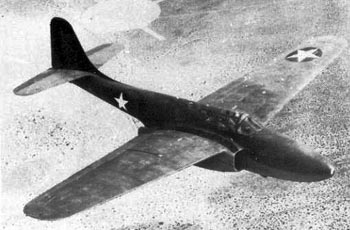P-59 Airacomet
|
|
| Bell XP-59 | |||
|---|---|---|---|
 | |||
| Description | |||
| Role | Fighter | ||
| Crew | one, pilot | ||
| Dimensions | |||
| Length | 11.63 m | 38 ft 2 in | |
| Wingspan | 13.87 m | 45 ft 6 in | |
| Height | 3.76 m | 12 ft 4 in | |
| Wing area | 35.9 m² | 386 ft² | |
| Weights | |||
| Empty | 3,600 kg | 7,940 lb | |
| Maximum | 5,760 kg | 12,700 lb | |
| Powerplant | |||
| Engine | 2x General Electric I-A turbojets | ||
| Thrust | 12.5 kN | 2,800 lbf | |
| Performance | |||
| Maximum speed | 664 km/h | 413 mph | |
| Range | 386 km | 240 miles | |
| Service ceiling | 14,080 m | 46,200 ft | |
| Rate of Climb | 975 m/min | 3,200 ft/min | |
| Armament | |||
| Guns | None P-59A - 1x 37 mm cannon 3x .50 cal (12.7 mm) machine guns | ||
The Bell P-59 was a fighter aircraft built in the United States during World War II. Its prototype, the XP-59 became the first jet-powered aircraft to fly in the US on October 1 1942. The type was produced in small numbers, but its performance was so unremarkable that the USAAF cancelled the contract when less than half of the aircraft ordered had been produced. No P-59s were ever sent into combat.
USAAF Major General Henry H. Arnold became aware of the United Kingdom's jet program when he attended a demonstration of the Gloster E.28/39 in April 1941. He requested, and was given, the plans for the aircraft's powerplant, which he took back to the US. On September 4, he offered General Electric a contract to produce American version of the engine. On the following day, he approached Lawrence Bell to build a fighter to utilize it. Bell agreed and set to work on producing three prototypes. As a disinformation tactic, the USAAF gave the project the designation P-59, which had previously been allocated to a completely unrelated Bell fighter project that had been cancelled. The design was finalized on January 9, 1942, and construction began. In March, long before the prototypes were completed, an order for thirteen YP-59 pre-production machines was added to the contract.
On September 12 1942, the first XP-59 arrived at Muroc Army Air Field (today, Edwards Air Force Base) in California for testing. While being handled on the ground, the aircraft was fitted with a dummy propeller to disguise its true nature. The aircraft first became airborne during high-speed taxiing tests on October 1 with Bell test pilot Robert Stanley at the controls, although the first official flight was made by Col Laurence Craigie the next day. Over the following months, tests on the three XP-59s revealed a multitude of problems including poor engine response and reliability (common shortcomings of all early turbojets) and performance that was far below expectations. Nevertheless, even before delivery of the YP-59s in June 1943, the USAAF ordered 80 production machines, designated P-59A Airacomet.
The YP-59 had a more powerful engine than its predecessor, but the improvement in its performance was negligible. One of these aircraft was supplied to the RAF in exchange for a Gloster Meteor. British pilots found that the aircraft compared very unfavourably to the locally produced jets that they were already flying. Three were also delivered to the USN where they were evaluated as the YF2L-1 but quickly found completely unsuitable for carrier operations.
Faced with their own ongoing difficulties, the USAAF cancelled the P-59A after only thirty aircraft had been completed. While the P-59 was not a great success, the type did give the USAAF experience with the operation of jet aircraft in preparation for the more advanced types that would shortly become available.
| Related content | |
|---|---|
| Related Development | |
| Similar Aircraft | |
| Designation Series | |
| Related Lists | List of military aircraft of the United States List of fighter aircraft List of World War II jet aircraft |
Reference
- William Green (1961). War Planes of the Second World War - Fighters, (Vol 4). London: MacDonald
External links
- http://home.att.net/~jbaugher1/p59.html
- http://www.wpafb.af.mil/museum/research/p59.htm
- http://www.globalaircraft.org/planes/p-59_airacomet.pl
- http://www.military.cz/usa/air/post_war/p59/p59_en.htm
- http://www.photovault.com/Link/Military/AirForce/Aircraft/P-59Aircomet.html
|
Lists of Aircraft | Aircraft manufacturers | Aircraft engines | Aircraft engine manufacturers Airports | Airlines | Air forces | Aircraft weapons | Missiles | Timeline of aviation |
